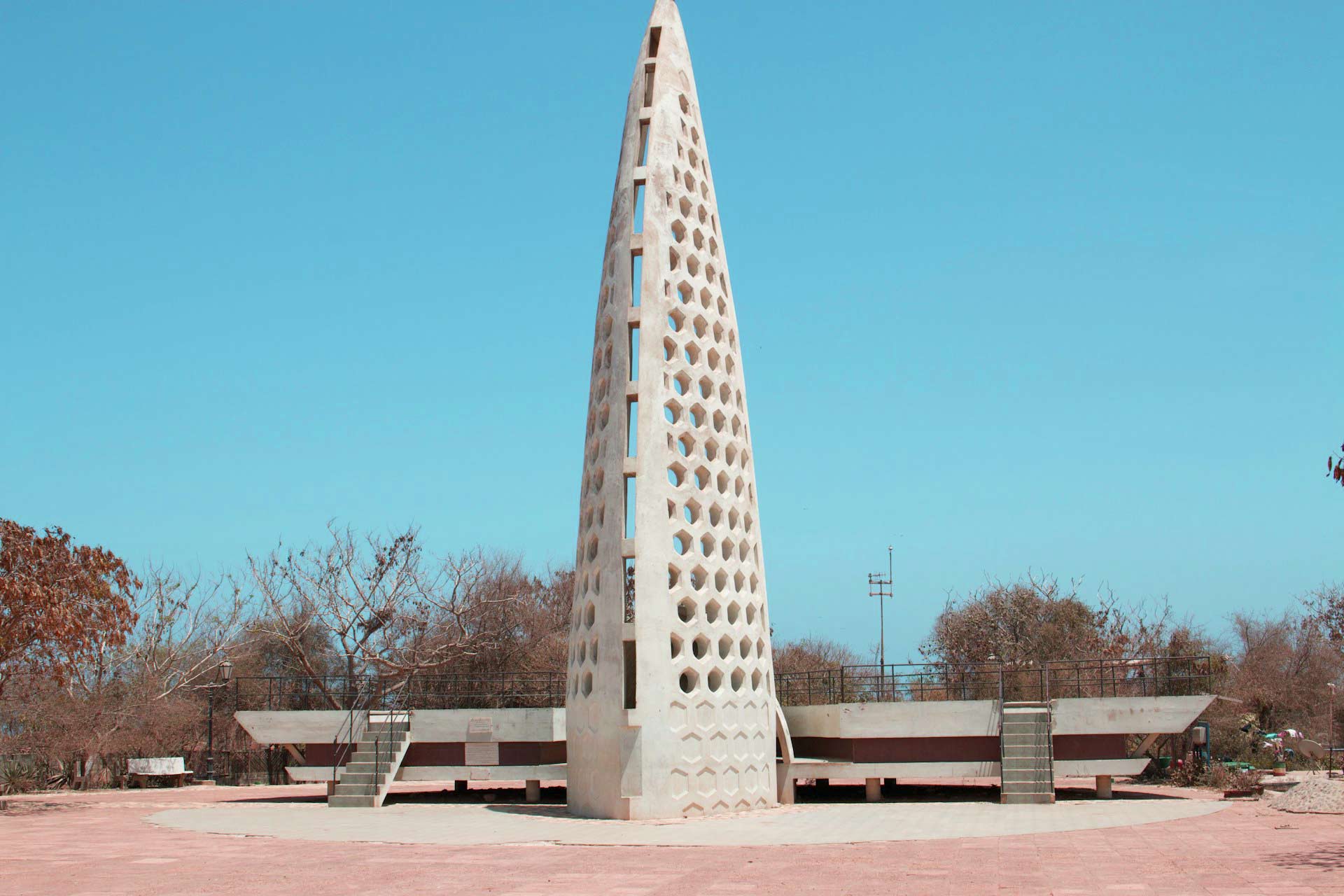West African Expedition: Senegal to Sahara
A cultural journey to Senegal, Mauritania, Western Sahara Province of Morocco
New tour with guaranteed departure
A true adventurer’s journey—travel from the coasts of Senegal into the sweeping Sahara Desert of Mauritania and Morocco. Discover fishing villages, colonial capitals and poignant historical sites before exploring the incredible Western Sahara, where traditions run deep and visitors are rare. Dive into ancient oases like Chinguetti and Ouadane, camp under the stars on untouched dunes, and experience unparalleled travel discovery with the logistics taken care of on this unique expedition.
| Tour Information | ||
|---|---|---|
| Duration | : | 24 days |
| Minimum | : | 2 persons |
| Maximum | : | N/A |
| Price (From) | : | |
| International air not included | ||
Day 01: Arrive Dakar (SENEGAL)
Arrive in Dakar. Transfer to your hotel, with the remainder of the day free.
Overnight: Hotel in Dakar (1 night)
Day 02: Dakar/Goree Island (Drive/Boat)
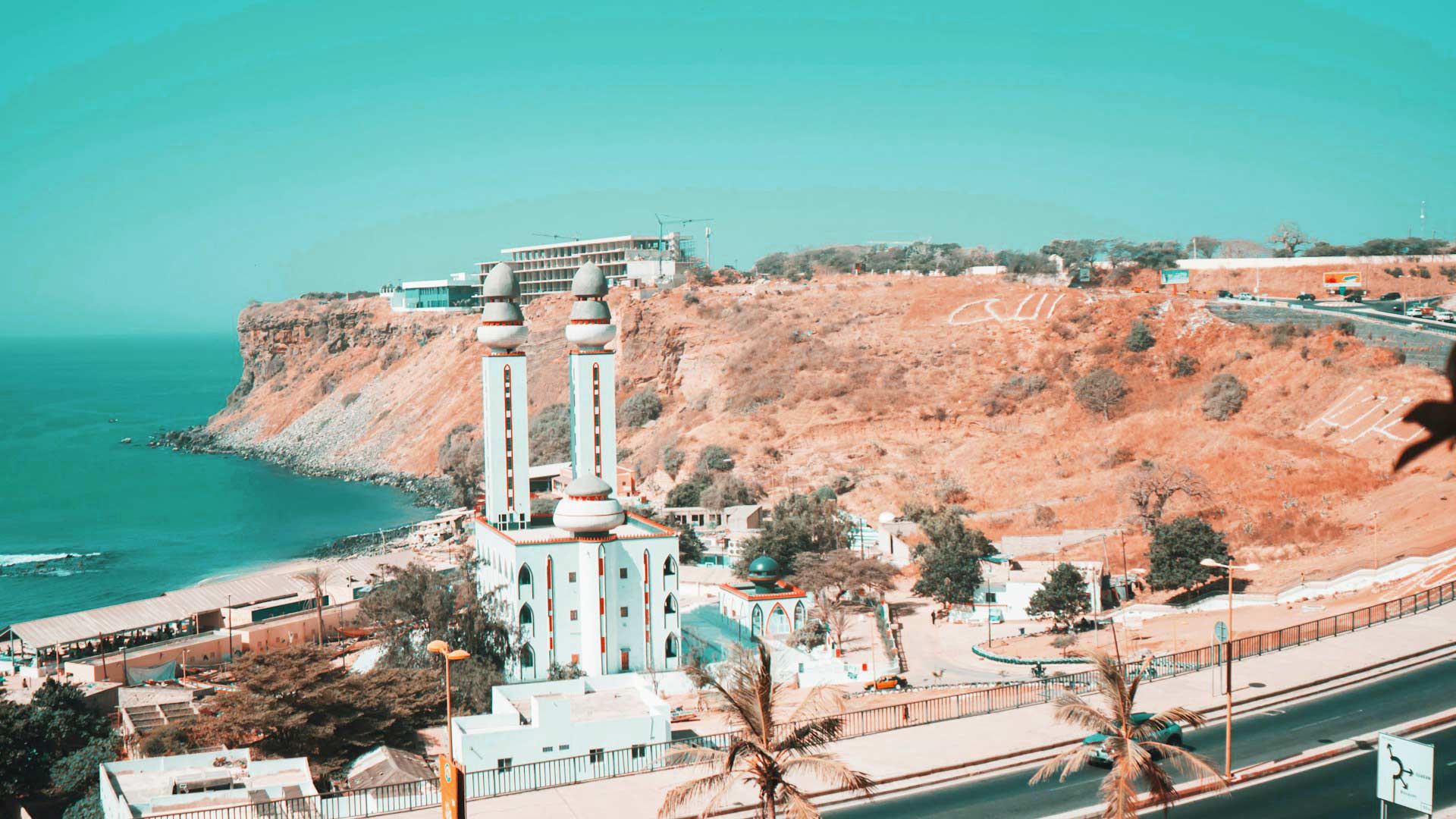
Morning free to recover from jetlag. Enjoy lunch at a fishing port restaurant, specializing in the catch of the day (other meals available on request). A ferry will take us to Gorée Island, just opposite Dakar. Gorée was once crowded with slaves awaiting shipment to the Americas. Fully restored, it stands today as a poignant reminder of those times. Its breezy climate, rich history, and historic architecture, combined with restaurants and boutiques, make Gorée a fascinating and stylish destination for both locals and visitors. The best time to experience the island’s atmosphere is at sunset, when day-trippers and tourists have left. Dinner at a typical restaurant and overnight stay at Maison Municipale, a guesthouse in a restored historic building with air-conditioned, self-contained large rooms, or similar.
Overnight: Maison Municipale, Goree Island (1 night) (B, L, D)
Day 03: Goree Island/Lac Retba (Boat/Drive)
Ferry to Dakar, the capital, which became a key centre of political, artistic, and intellectual renewal during the independence era and remains the liveliest metropolis in French-speaking West Africa. Visit the Musée des Civilisations Noires, featuring impressive collections of tribal art, textiles, and works by contemporary local artists. Explore the Plateau district, including the Presidential Palace, a typical market, and the fully restored Dakar-Bamako railway station, a fine example of colonial architecture.
Part 2 ends here in Dakar with transfer to the airport.
Drive to Lac Retba, a saltwater lake framed by dunes. The water is saltier than the ocean, allowing for a unique floating experience. Dinner and overnight stay at the recently renovated Trarza Hotel, comfortable and overlooking the lake, with air-conditioned, self-contained rooms.
Overnight: Trarza Hotel, Lac Retba (1 night) (B, L, D)
Day 04: Lac Retba/Saint Louis (Drive)
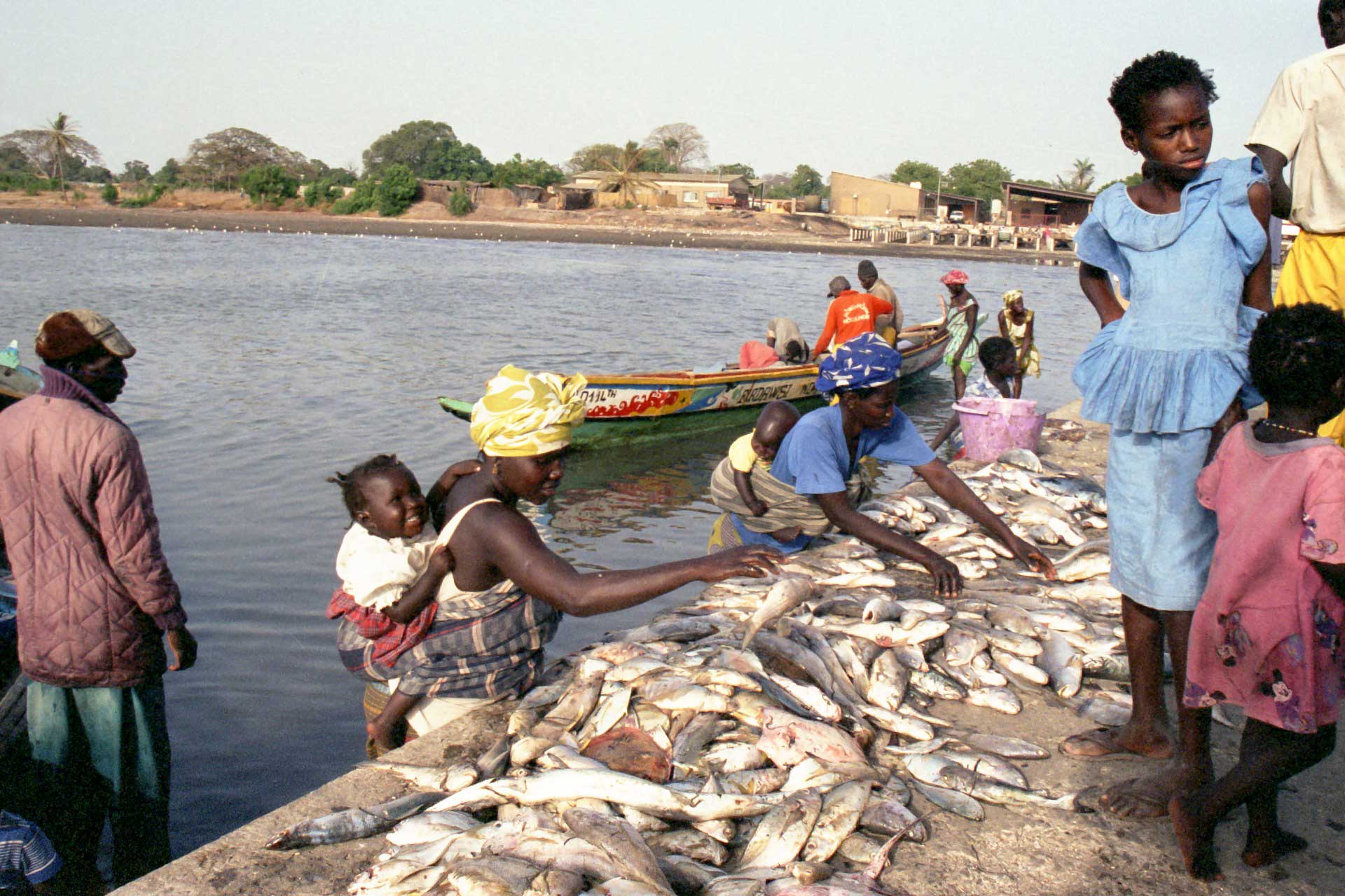
Kayar, the largest fishing village in Senegal, welcomes more than 4,500 painted wooden pirogues returning to shore with the day’s catch. On the beach, local market women purchase the fish directly from the fishermen. We will also meet the artisans carving the large pirogues, the painters decorating them with vibrant colours, and, if fortune allows, the “local saint” for a final blessing before sailing.
If available, we will be received by the Marabout in his spacious house, where he will introduce us to ancient geomantic and cabalistic divination techniques.
Drive to Saint Louis for a late lunch to enjoy Senegalese cuisine, renowned as the best in West Africa. Evening arrival at our base for two nights, the Hotel de la Poste. Built in 1850 as a base for Aeropostale pilots, this historic hotel has been fully restored while preserving the town’s colonial charm. Dinner will be served in its charming open-air restaurant overlooking the calm Senegal River.
Overnight: Hotel de la Poste, Saint Louis (2 nights) (B, L, D)
Day 05: Saint Louis – Historic Old Town
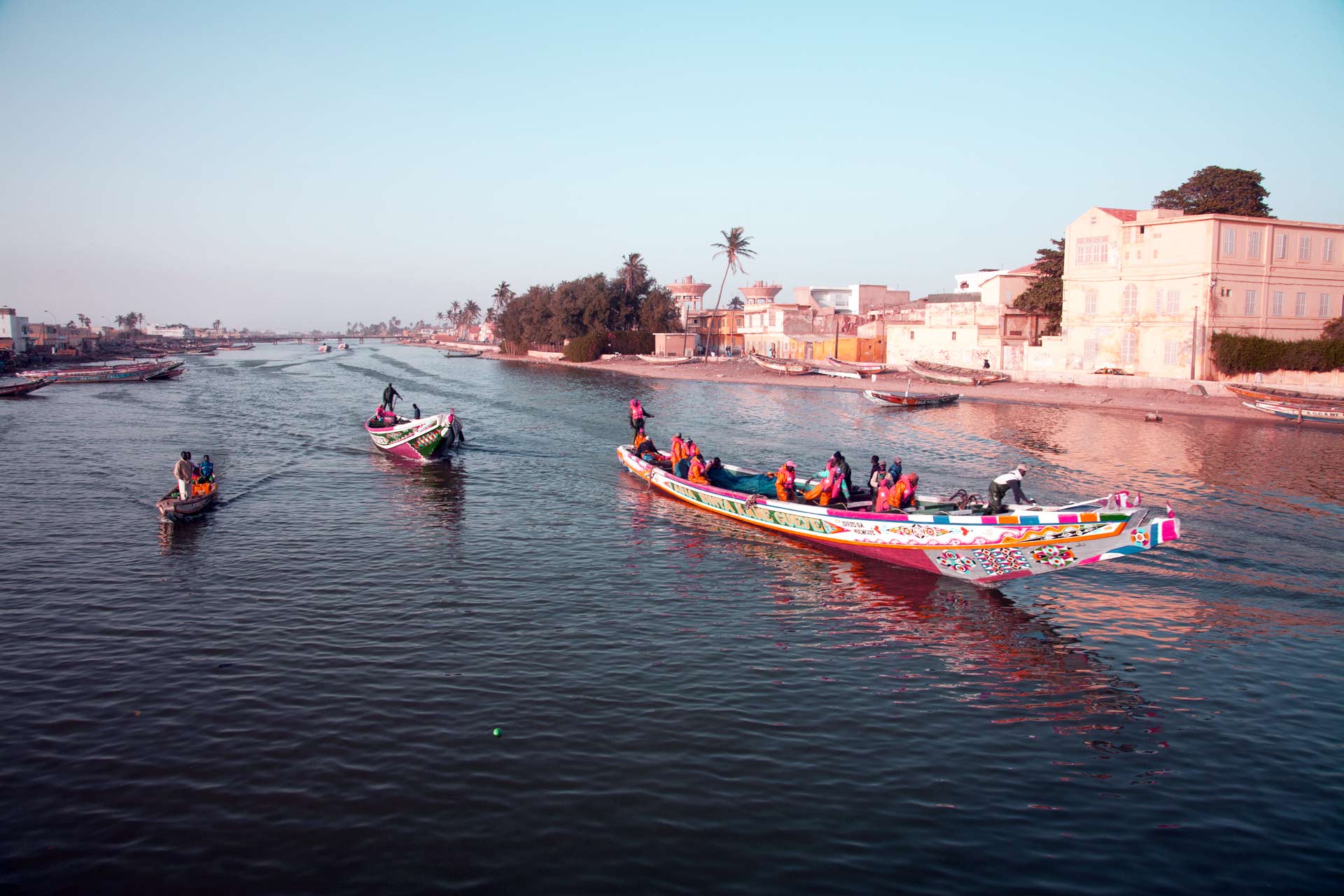
Full day dedicated to Saint Louis, a charming historic citadel and the first capital of the French colonies in West Africa. The old town, built on two long islands between the Senegal River and the ocean, enjoys a refreshing breeze. One island served as the administrative colonial capital of French West Africa until 1902, when the administration moved to Dakar. Old French and Portuguese buildings, restaurants, bars, and art galleries give this small island town a unique charm. The photography museum is especially interesting, highlighting the achievements of some of Sub-Saharan West Africa’s great photographers.
The second island, closer to the ocean, is home to a large local fishing community. The best way to explore the narrow streets of Saint Louis is by calash (horse-drawn buggy), just as the locals do.
Dinner and overnight return to our base at Hotel de la Poste, a historic hotel built in 1850 as the base for Aeropostale pilots. Fully restored, it retains the finest colonial atmosphere and offers a charming restaurant overlooking the Senegal River. (B, L, D)
Day 06: Saint Louis/Nouakchott (Drive) (MAURITANIA)
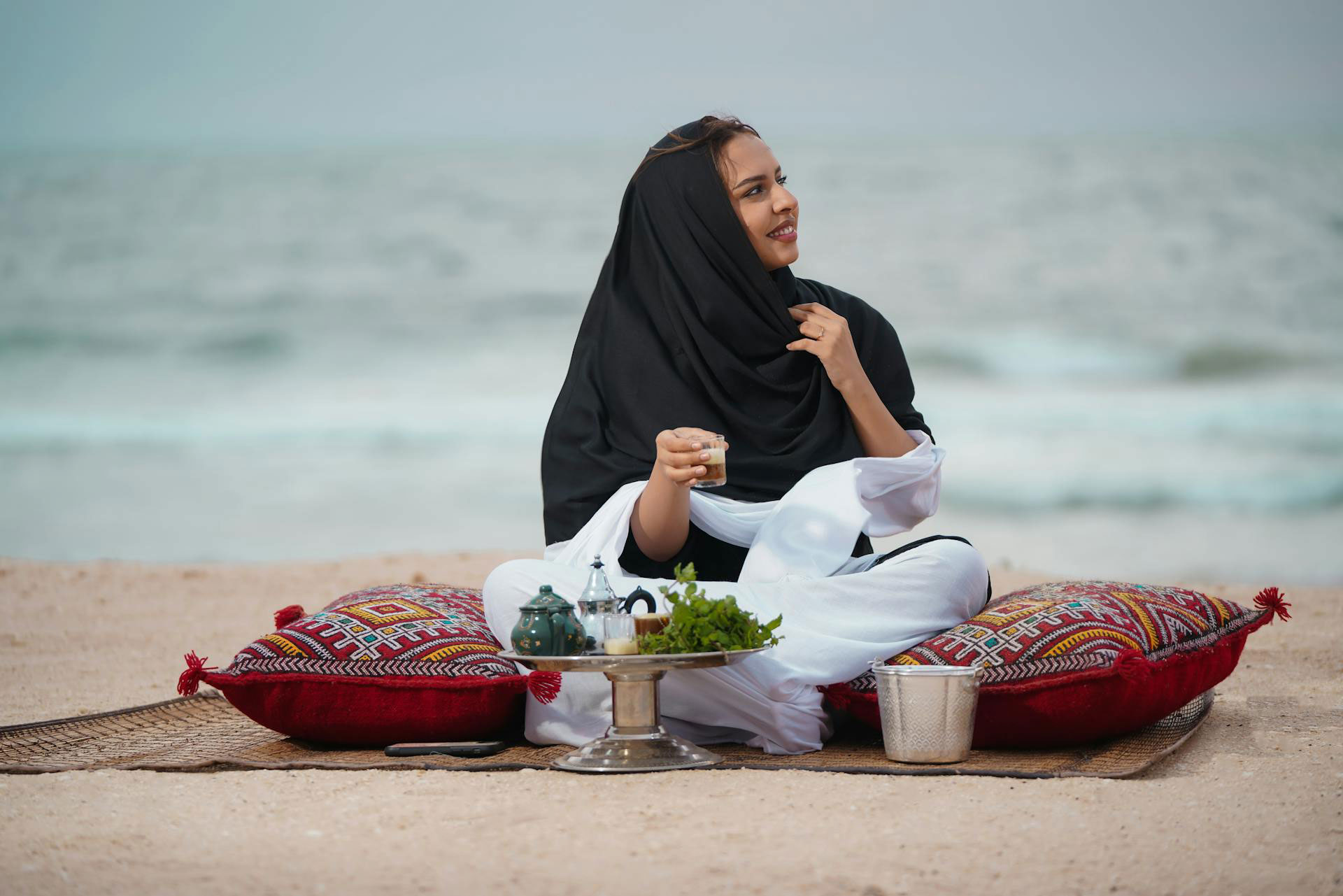
Early morning departure to Djoudj National Park, a remarkable environment stretching across hundreds of miles of partially flooded land between the Sahara and the arid Sahel. This “humid paradise” provides the ideal habitat and nesting grounds for over a million migratory and resident birds. Djoudj National Park is one of the world’s three major migratory bird sanctuaries and a UNESCO World Heritage Site. Its protected wetlands host more than 400 species of migratory birds that temporarily inhabit this unique environment. We will take a boat excursion to explore an island teeming with pelicans.
The journey continues to the Mauritanian border, where the landscape transforms dramatically from flooded plains to dry savannah and finally to the Sahara with its sweeping dunes. Evening arrival in Nouakchott, the capital of Mauritania, a modern city surrounded by the desert. Dinner and overnight at the four-star Azalai Hotel, featuring comfortable air-conditioned rooms with private facilities, international standards.
Overnight: Azalai Hotel (4-star), Nouakchott (1 night) (B, L, D)
Day 07: Nouakchott/Akjoujt (Drive)
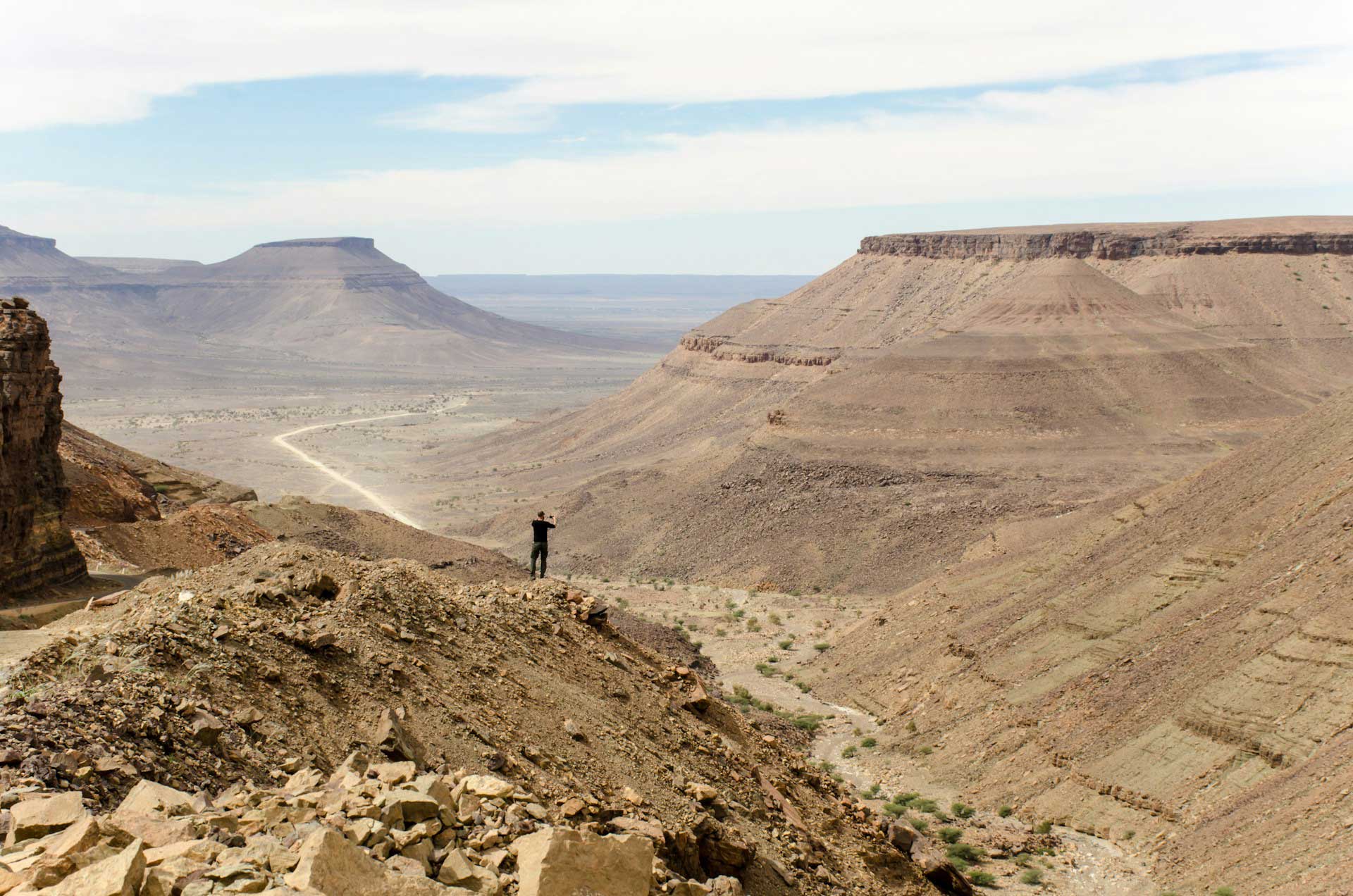
From the desert to the ocean, from Black Africa to the Sahara.
As a summary of Mauritanian history and culture, we visit the National Museum, showcasing archaeology, artifacts, costumes, and textiles from prehistory to the present. Unique photographs from the excavations of Aoudaghost, the northern trading town and best-preserved site of the legendary Ghana Empire, are on display. The Ghana Empire, dating from the 6th century, was the oldest known empire and kingdom in Black Africa. At that time, caravans transporting gold to North Africa departed from Aoudaghost, passing through Ouadane and Assa, which we will explore during our Sahara crossing.
Lunch will be served in a restaurant run by Ivorian women, offering their specialities. In the afternoon, we drive north along a spectacular dune-strewn road into the Sahara Desert, arriving at the mining town of Akjoujt. Dinner and overnight stay at Hotel du Sahara, a modern hotel with fully air-conditioned, self-contained rooms.
Overnight: Hotel du Sahara, Akjoujt (1 night) (B, L, D)
Day 08: Akjoujt/Chinguetti (Drive)
Early departure for a full day exploring one of Mauritania’s most scenic landscapes: valleys, high mountains, yellow sand dunes, and peaks of dark brown and red rocks hiding adobe villages.
Off the main tracks, we cross Erg Amatlich, a vast dune basin nestled among the Adrar mountains. This region combines endless dunes with a remarkable variety of Saharan landscapes, including canyons, small cultivable oases, and palm groves.
We will discover prehistoric stone arrowheads and earthenware shards, silent witnesses to the people who lived here long ago, when this region was green and crossed by large rivers. Joyful voices and the cries of women and children will welcome us to remote nomadic camps and hidden adobe villages, offering intense human encounters amid the vast silence of the Sahara.
The Tifoujar Pass overlooks a vast, steep gorge, a remnant of an ancient river that ends in the Oued el Abiod, or White Valley. The dark brown mountains contrast vividly with the deep yellow dunes filling the valleys as far as the eye can see.
Evening arrival in Chinguetti, which will be our base for three days exploring one of the most fascinating regions of the Sahara, surrounded by untouched dunes and ancient oases.
Dinner and overnight stay at La Gueila, a cozy guest house built in traditional Mauritanian style (or a private comfortable residence). Air-conditioned rooms, hot water, and Wi-Fi are available. The fine restaurant serves local specialities with a French touch.
Overnight: La Gueila, Chinguetti (3 nights) (B, L, D)
Day 09: Chinguetti – Ancient Citadels & Mosques
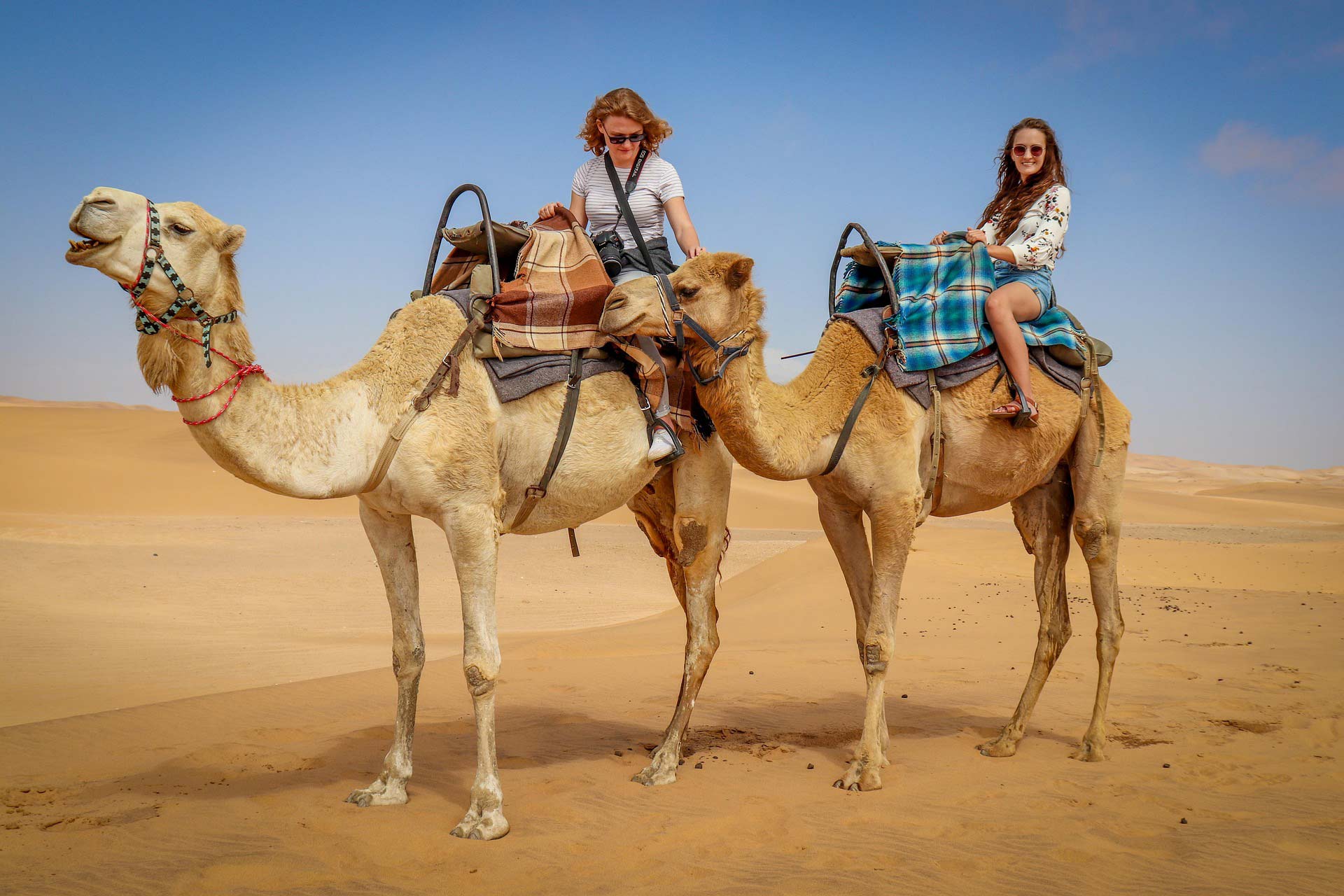
The stone citadel of Chinguetti, dating back to the 13th century, was a key crossing point for several trans-Saharan routes linking the Mediterranean coast to Black Africa. The old stone town, its architecture, the ancient manuscript collections from the Middle Ages, and the oasis with their “green miracles” of palm trees and gardens amid the vast Sahara are the highlights of Chinguetti. Large chains of yellow dunes form the town’s western boundary, as it resists being swallowed by the sand.
The main mosque and stone minaret are remarkable: Chinguetti Mosque is the second oldest still operating in the Muslim world.
We will spend the day immersed in the magical atmosphere of this desert citadel, considered the jewel of Mauritanian oases, exploring two ancient manuscript collections, including Ould Habott, the largest in Mauritania. Evening return to our cozy guest house. (B, L, D)
Day 10: Chinguetti – Deserts & Oases
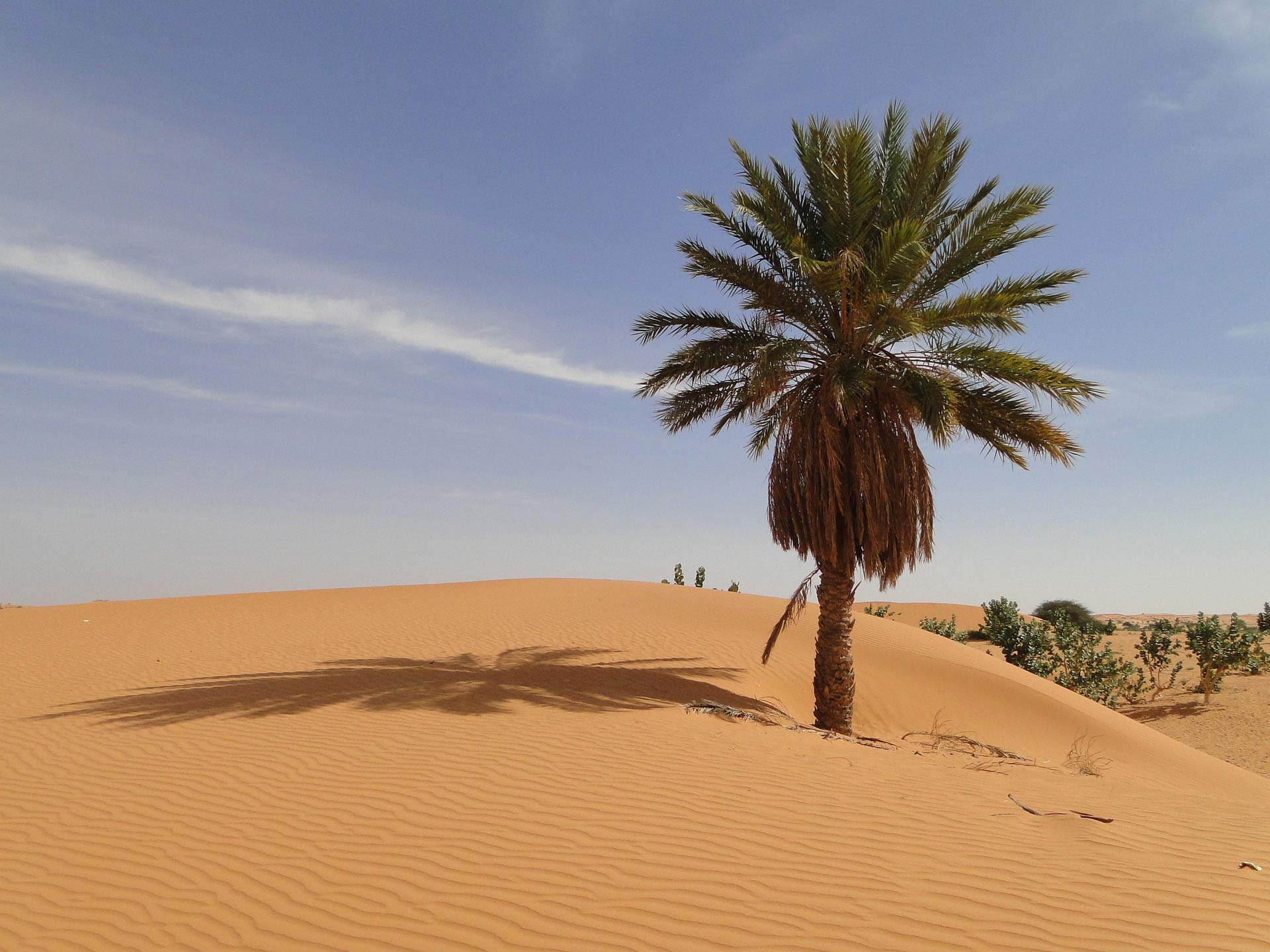
We will journey to Ouadane on an “off the beaten track” itinerary, following the Ouadi (dry creek) and discovering remote tiny oases hidden among the high dunes. Ouadane is the most isolated oasis in Mauritania, an outpost in the emptiest part of the Sahara. Founded in 1147, much of the town is in ruins, yet some stone houses perched on a rocky hill amid the vast desert remain inhabited.
In ancient times, Ouadane was an important caravan trading point between the Maghreb and Black Africa. Trade was so flourishing that in 1487 the Portuguese built a fortified trading post in the region. The stone architecture of Chinguetti and Ouadane will echo throughout our Sahara crossing, reappearing a thousand miles north at the next major caravan terminal on the way to Marrakech.
After this fascinating day, we return to our cozy guest house in Chinguetti. Dinner and overnight stay at La Gueila (or private residence). (B, L, D)
Day 11: Chinguetti/Akjoujt (Drive)
The landscape never ceases to amaze. Leaving the main track, we reach a region of spectacular mountains, gorges, and canyons, with infinite space dominated by the ochre earth and deep blue sky. On the horizon, the ruins of Fort Saganne appear, built for the film of the same name.
We explore the Agrour site atop the Amogjar Pass, where cave paintings depict bovids, hunters, and herders. Later, we arrive at Terjit, one of the most lush and distinctive oases in Mauritania. Walking through a dense palm grove protected by a gorge and following a tiny stream, we discover a vast rock shelter with flowing spring water—an unexpected oasis disconnected from time and the harsh desert around it.
Drive along roads and tracks to reach the main route toward Nouadhibou. Dinner and overnight at Hotel du Sahara (or similar), a new hotel with air-conditioned, self-contained rooms.
Overnight: Hotel Du Sahara, Akjoujt (1 night) (B, L, D)
Day 12: Akjoujt/Nouadhibou (Drive)
Continue the drive to Nouadhibou, a modern coastal town on the Gulf du Lévrier, known for its international fishing harbor and the terminal of the world’s longest iron-transport railway. Explore the town at leisure and enjoy its coastal atmosphere.
Overnight stay at El Medina Hotel, comfortable international standard, air-conditioned rooms.
Overnight: El Medina Hotel, Nouadhibou (1 night) (B, L, D)
Day 13: Nouadhibou/Dakhla (Drive) (MOROCCO)
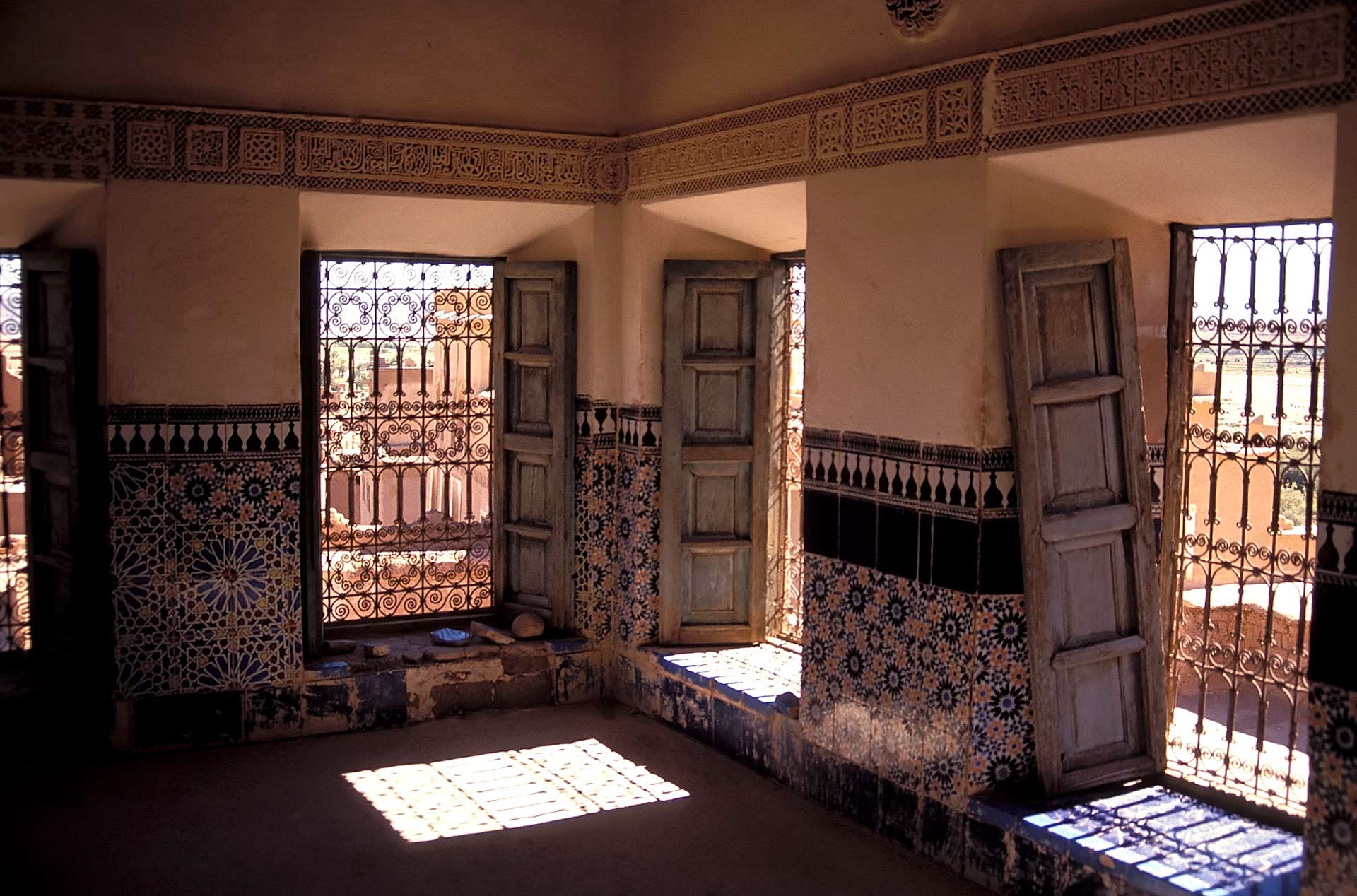
We drive north and, after completing formalities, we cross a few miles of “no-man’s land,” where the border is merely a theoretical line in the desert dividing sand from sand. On the other side lies the Moroccan military post, a highly sensitive location and the only open border between Black Africa and the Maghreb. This region, formerly part of Spanish Sahara, was once the site of a long conflict between the Polisario Armed Front and the Moroccan army. Today, it is fully part of Morocco.
A signboard in the vast desert marks the Tropic of Cancer. The final stretch of the journey follows a spectacular cliff where the dunes meet the ocean waves.
We arrive in Dakhla, which will be our base for two nights. We stay overnight at the Buena Vista Hotel, an international 4-star property, ocean-facing, with air-conditioned rooms and private facilities, or a similar hotel.
Overnight: Buena Vista (4-star), Dakhla (2 nights) (B, L, D)
Day 14: Dakhla – Ocean & Desert
The Rio de Oro, or River of Gold, is a 25-mile-long sea loch nestled between cliffs and dunes. The scenery is painted with different colours: the intense blue of the ocean, banks of white sand, green seaweed fields, and yellow dunes. The exceptional beauty of this landscape makes the Dakhla peninsula a truly special place.
The small town of Dakhla was founded by Spanish navigators in 1502 and was called Villa Cisneros until recent times. We take an excursion to the colourful fishing harbour. Along the shore, we observe a unique and ever-changing shoreline between ocean and desert, where dunes and waves meet. At high tide, sand dunes and a rocky hill become temporary islands.
Our preferred restaurant is located in an oyster farm, where we enjoy fish, oysters, and other shellfish freshly taken from the ocean, along with grilled vegetables and more. Vegetarian meals are available on request.
We return overnight to our 4-star, international standard hotel, the Buena Vista, facing the ocean, with air-conditioned rooms and private facilities. (B, L, D)
Day 15 & 16: Dakhla/Sahara (Drive)
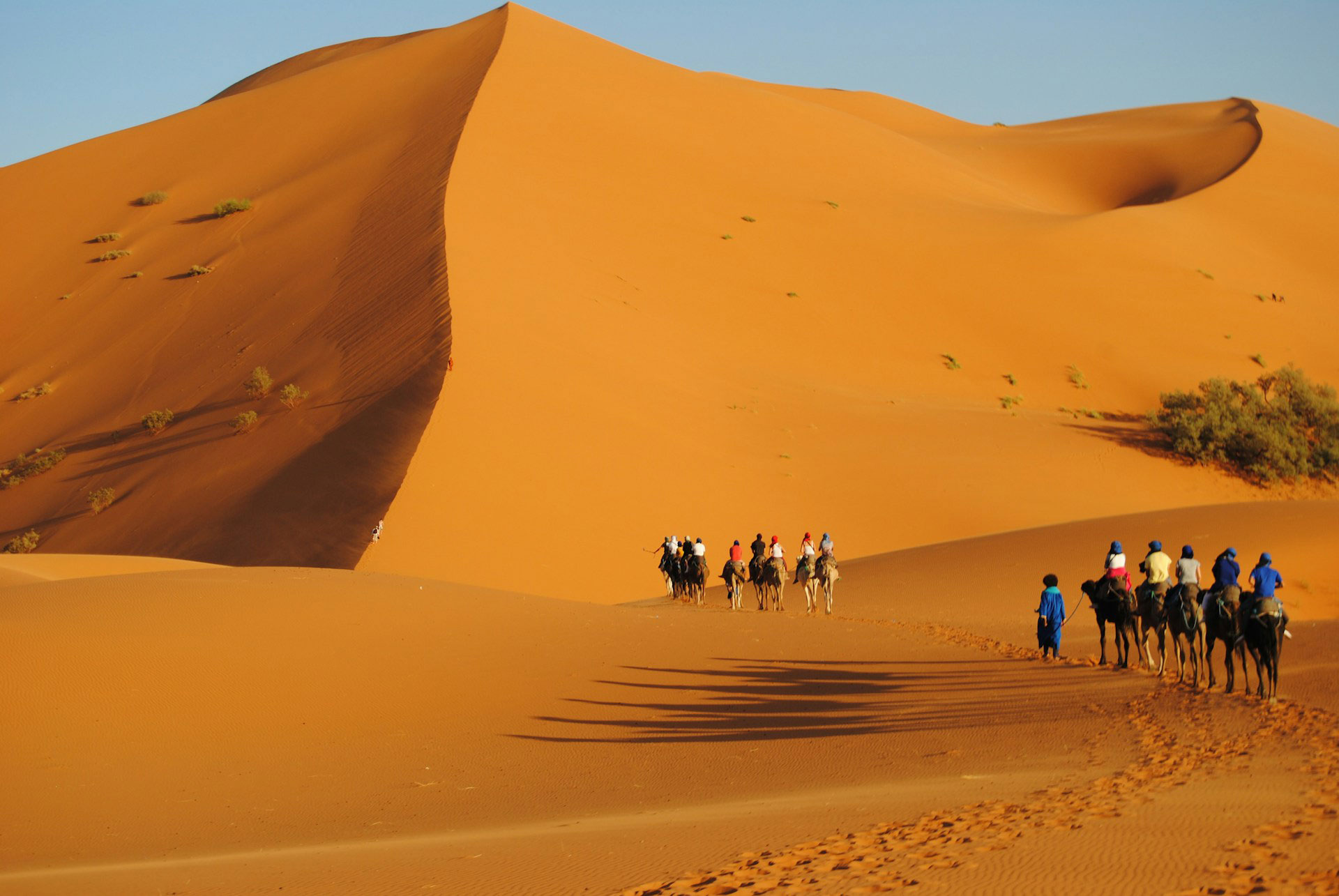
We meet our local guide, a nomad from a Sahrawi tribe, who will lead us for three days through a true desert crossing in the Western Sahara, now the Sahara Province of Morocco.
Since the second half of the seventies, due to the long “sand war,” this region has been off-limits to travellers. Until today, no peace treaty has been signed, but a cease-fire is respected. This is a region for intrepid travellers to discover.
During this extreme Saharan expedition, we cross large dunes and leave the tracks to discover wells frequented by long lines of camels belonging to the legendary Reguibat nomads.
On days 47 and 48, we camp on the virgin sand of the Sahara. Comfortable large tents include mattresses, carpets, and chairs. Dinner is served at the table under the stars, featuring local specialities and a choice of red wine, white wine, beers, and sodas.
Overnight: Sahara Camp (2 night) (B, L, D) (B, L, D)
Day 17: Sahara/Tarfaya (Drive)
After crossing the world’s longest automated conveyor belt, which transports phosphate to the Atlantic, we arrive in Laayoune, the main base of Morocco’s economic development in the Sahara provinces.
In the late afternoon, we reach Tarfaya on Cape Juby, opposite the Canary Islands, which are less than 100 kilometers away. Tarfaya was a former base of Aeropostale, a pioneer of air mail transport from Europe to Africa and Latin America. We visit the interesting museum dedicated to Aeropostale and Saint Exupéry, the writer-pilot.
Overnight stay at Hotel Casamar, with air-conditioned rooms and private facilities.
Overnight: Hotel Casamar, Tarfaya (1 night) (B, L, D)
Day 18: Tarfaya/Tifnidilt (Drive)
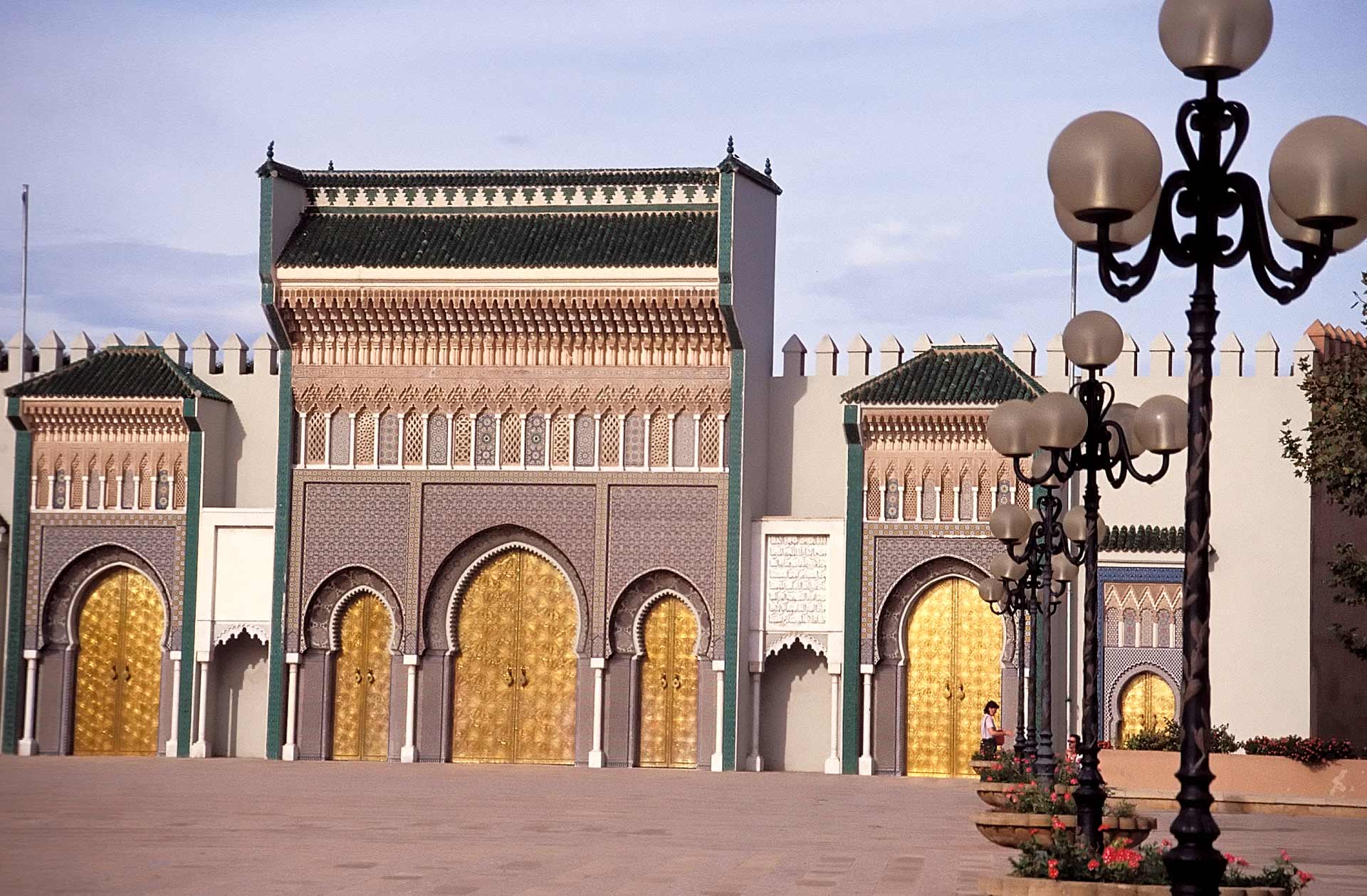
The Naila Lagoon is a unique inland arm of the sea, separated from the ocean by rows of dunes that create a special ecosystem inhabited by migratory and resident birds. With a local fishing boat, we explore the remote shores.
After lunch in a local restaurant, we visit a ghost military fort, which still guards the former borders between the French protectorate of Morocco and the Spanish Sahara. The atmosphere evokes the set of an old Foreign Legion movie.
In the evening, we arrive at the comfortable Ksar Tifnidilt, or similar. Air-conditioned rooms with private facilities will be our base for two nights. The hotel is built using local materials in a traditional Saharan style.
Overnight: Ksar Tifnidilt, Tifnidilt (2 nights) (B, L, D)
Day 19: Tifnidilt – Fishing Villages & Ghost Outposts
Early morning leaving Tifnidit to cross steep range of dunes.
The Dra estuary region and Cape Dra are visited only by brave travellers.
Between the cliffs and the Atlantic Ocean there are not paved roads. We will discover tiny temporary settlements of fishermen, ghost colonial military posts, dunes, and camels.
For lunch we will be guests of the fishermen, a pleasant way to contribute to the local economy by enjoying super-fresh grilled fish (vegetarian also available).
A steep descent will take us to a river bed in a canyon, the only access to the ocean for an exciting drive on the 'white beach' between sand, waves and sea eagles.
Return to Ksar Tifnidilt. (B, L, D)
Day 20: Tifnidilt/Icht (Drive)
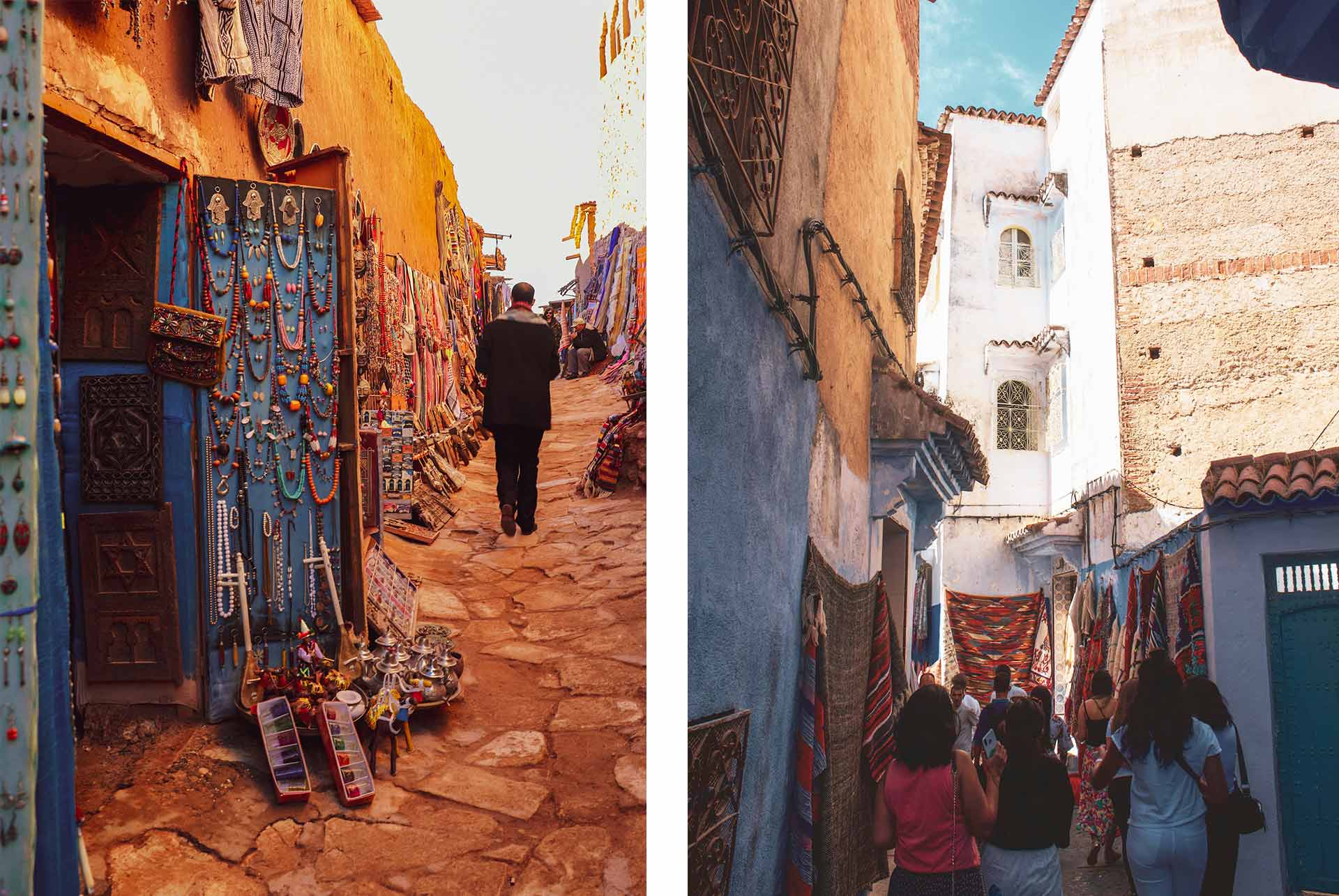
Guelmim was an important trans-Saharan terminal, and in the souk we can still see remnants of the caravan trade. Our schedule coincides with the perfect day to visit the camel market. Camel herders from all over southern Morocco and even from Mauritania come to buy and sell these animals, as well as other products from their regions.
In the rarely visited Assa region, we discover the same Arab-Berber stone architecture that we saw more than a thousand kilometres south, in the oases of Chinguetti and Ouadane. In ancient times, these citadels were connected to Marrakech through Assa as part of a caravan route for gold, ivory, and slaves, which we are now retracing.
Evening arrival at the small oasis of Icht, staying at the best hotel in the region. Dinner and overnight are at Borji Biramane, featuring air-conditioned self-contained bungalows, a swimming pool, and Wi-Fi, or similar.
Overnight: Borji Biramane, Icht (1 night) (B, L, D)
Day 21: Icht/Foum Zguid (Drive)
We cross a region of spectacular landscapes, with rocky mountains and large oases. We leave the main road to discover prehistoric rock art, including an ancient graffito depicting a rhinoceros, an animal long extinct here, remnants of a time when the present Sahara was green grassland. We walk through the oasis to experience a green miracle surrounded by an arid environment. Lunch is at a local restaurant.
After an intense day driving off-road across high ranges of dunes, we reach the picturesque oasis of Foum Zguid. From adventure to comfort, dinner and overnight are at the super comfortable Bab Rimal. The hotel features air-conditioned self-contained bungalows, Moroccan-style furniture, a swimming pool, and Wi-Fi. Or similar.
Overnight: Bab Rimal, Foum Zguid (1 night) (B, L, D)
Day 22: Foum Zguid/Mahamid (Drive)
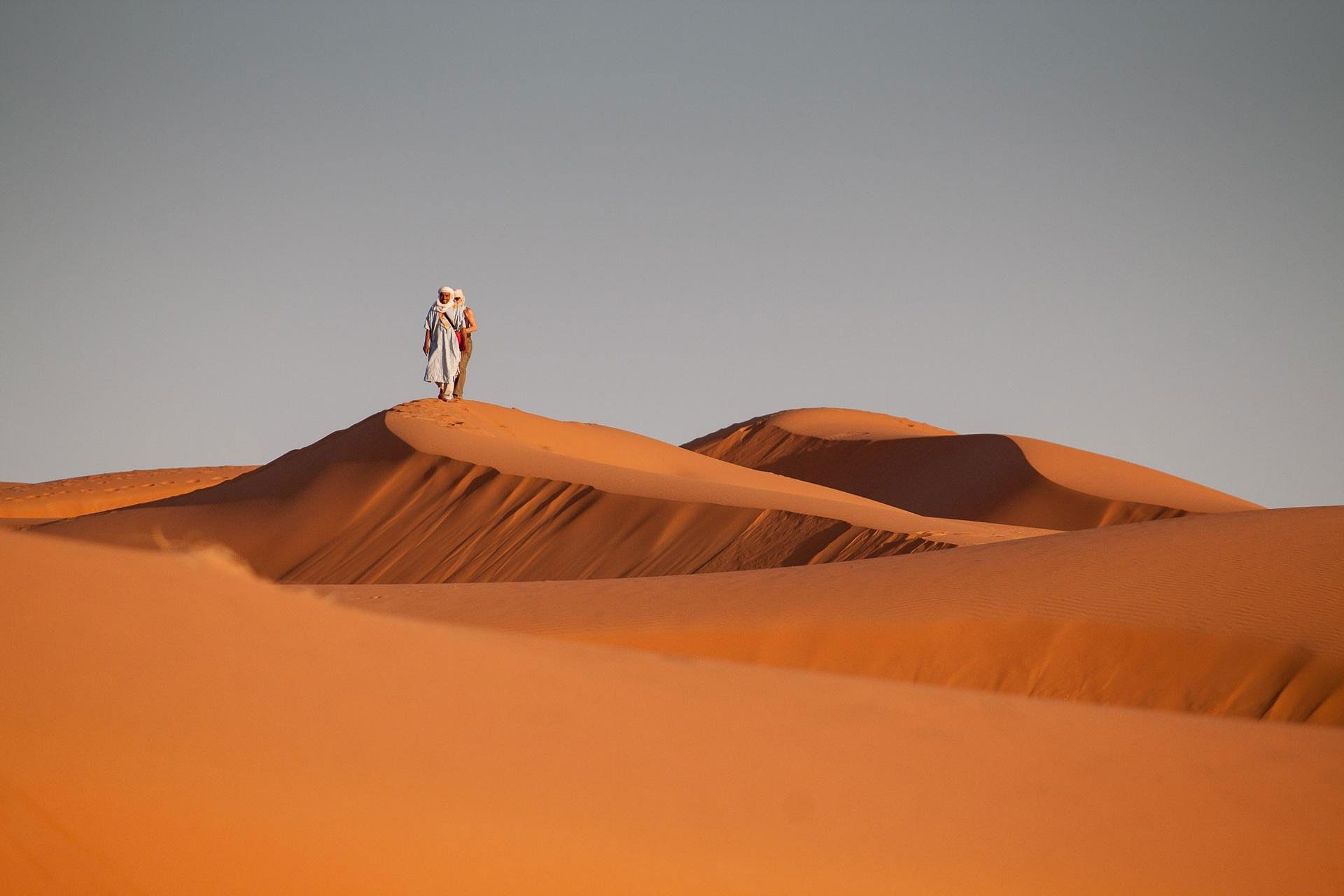
We follow an off-road itinerary to cross the spectacular landscape of the Iriki dry Lake through a flat, salty plain. We discover an ancient seabed with rocky hills where, looking attentively, we can find some fossils.
The tall dune ranges of Erg Chegaga bar our way, and only the expertise of our driver will lead us through sand labyrinths on an unforgettable journey, finding our way across steep dunes on the northern edge of the Sahara, the wildest desert on earth.
Dinner and overnight are at the comfortable Hotel Pacha in the Mahamid oasis. The hotel features air-conditioned self-contained rooms and Wi-Fi, or similar.
Overnight: Bab Rimal, Foum Zguid (1 night) (B, L, D)
Day 23: Mahamid/Ouarzazate (Drive)
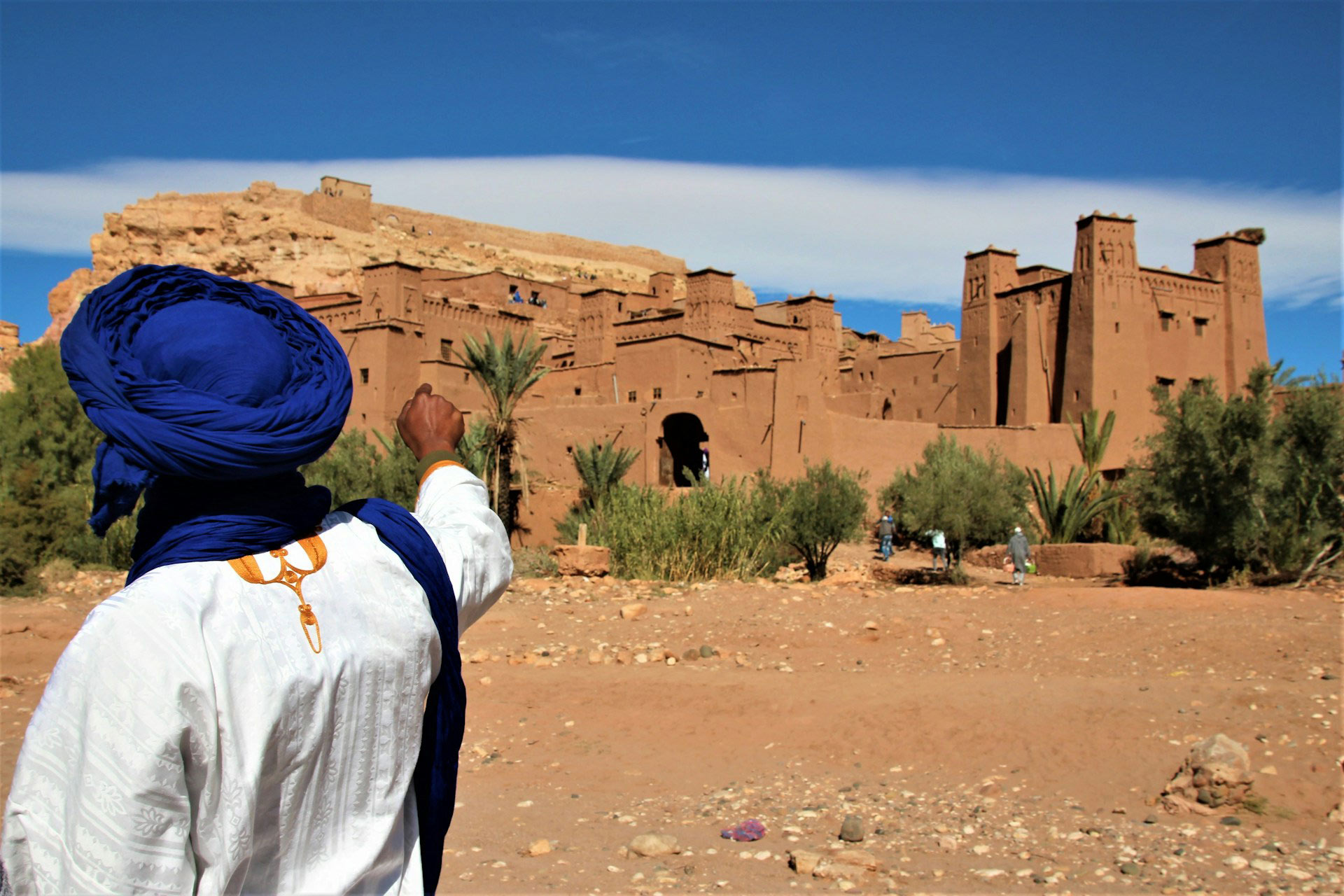
Morning departure following the spectacular road that crosses the Dra Valley and Berber villages.
We visit an ancient rock art site with hundreds of fine graffiti dating back thousands of years, silent testimony to the peoples who lived in these regions before desertification.
Arrival in Ouarzazate, a large oasis at the edge of the desert. Dinner and overnight stay are at the Ibis, an international hotel built in local architecture. The hotel offers comfortable air-conditioned self-contained rooms with Wi-Fi and a swimming pool. No twin rooms are available.
Overnight: Ibis Hotel, Ouarzazate (1 night) (B, L, D) – No Twins available
Day 24: Ouarzazate/Depart Marrakesh (Drive)
Departure in the morning.
Ait Benhaddou is located along the ancient caravan route connecting Marrakech to the Sahara. Over the years, many famous films have been shot in this Ksar, including Lawrence of Arabia, Sodom and Gomorrah, Oedipus Rex, The Sheltering Sky, The Jewels of the Nile, Jesus of Nazareth, Alexander, Gladiator, and more.
We head north to cross the spectacular High Atlas range on a panoramic route through the Tin Tichka pass at 2,260 meters. Along the way, we meet local gem seekers in search of amethyst, tourmaline, and other stones. With a bit of luck, we may be able to find our own gems.
Arrival in Marrakech in the early evening. Marrakech, a traditional caravan terminal, is the ideal end of our modern caravan. Day-rooms will be available in a hotel for a final shower before the transfer to the airport. Meals are not included.
Day use rooms. (B)
B=Breakfast, L=Lunch, D=Dinner
Departure Dates & Prices
We accept payments in US$, CA$ as well as in other convertible currencies like EUR, AUD and GBP. Tour prices have been costed in US$. CA$ price shown below is an indicative amount reached at by using the conversion rate at the time of web posting and will be applicable if there is no change in the conversion rate. Should the currency conversion rate change, the US$ pricing will prevail. Bestway Tours & Safaris offers a conversion rate protection. Once full payment has been received and no modification has been made to the tour itinerary, we will honour that rate. For complete payment procedures, please click here
| 2026 | Per Person on Twin Sharing |
Single Room Supplement |
|---|---|---|
| Departures | ||
| APRIL 2026: Start in Dakar on April 6, 2026 & end in Marrakesh on April 29, 2026 | ||
| April 6, 2026 | US$ 11656 | US$ 1073 |
Reduction of US$ 2376 per person if 6 or more guests confirm on departure.
Reduction of CA$ 3420 per person if 6 or more guests confirm on departure. |
||
| NOVEMBER 2026: Start in Marrakesh on November 9, 2026 & end in Dakar the evening of December 2, 2026 | ||
| Based on 2 or 3 participants | US$ 13455 | US$ 1073 |
| Based on 4 or 5 participants |
US$ 11656 | US$ 1073 |
| Based on 6+ participants |
US$ 9280 | US$ 1073 |
| 2026 | Per Person on Twin Sharing |
Single Room Supplement |
|---|---|---|
| Departures | ||
| APRIL 2026: Start in Dakar on April 6, 2026 & end in Marrakesh on April 29, 2026 | ||
| April 6, 2026 | CA$ 16773 | CA$ 1545 |
Reduction of US$ 2376 per person if 6 or more guests confirm on departure.
Reduction of CA$ 3420 per person if 6 or more guests confirm on departure. |
||
| NOVEMBER 2026: Start in Marrakesh on November 9, 2026 & end in Dakar the evening of December 2, 2026 | ||
| Based on 2 or 3 participants | CA$ 19362 | CA$ 1545 |
| Based on 4 or 5 participants |
CA$ 16773 | CA$ 1545 |
| Based on 6+ participants |
CA$ 13354 | CA$ 1545 |
Guaranteed Departures
| This tour can also be taken in smaller legs. Please contact us for details if you are interested in a specific segment. |
Notes
- Important note on visas: After booking, please contact us immediately via visas. We will provide advice and suggestions on how to obtain the E-Visas and when Invitation Letters are required, even if not explicitly requested by local authorities. Visa rules are frequently updated, so we will send the most current information available.
- Deposit is 30% of tour price.
- Climate: Climate: This departure is scheduled to take advantage of ideal weather. Spring falls within the dry season, making it the best time to explore West Africa.
- Comfort: To truly enjoy a long journey off the beaten path, comfort is essential. For rough tracks and desert dunes, we use modern 4x4 vehicles with air-conditioning, while well-maintained minibuses handle the smoother main roads. Overnight stays include four-star (****) or character-rich hotels in the capitals, and newer properties with private bathrooms and air-conditioning elsewhere. Each accommodation is selected for its comfort, quality dining, friendly atmosphere, architectural charm, and scenic setting.
- Safety: Your well-being comes first. This expedition is backed by years of regional expertise and led by experienced guides. A trusted local network provides constant monitoring and real-time updates, ensuring the route remains secure at all times.
Expedition leaders have extensive experience guiding travelers off the beaten track in this region, with an excellent understanding of African culture and traditions.
This is an exploratory itinerary. Participants must be flexible and ready to enjoy unique encounters, as well as some unexpected situations that are part of the African experience. - Vaccinations: Yellow fever is compulsory. Malaria prophylaxis is highly recommended. Cholera is not currently required, but please check prior to departure.
- Luggage: Due to the exploratory nature of the itinerary, luggage should be limited to approximately 20 kg (45 lbs).
- Travel insurance: Not included. It is mandatory for medical assistance, repatriation, and coverage of material or physical damages.
- Hotels: We have carefully selected hotels for quality of service and, where possible, architectural character. Due to potential room availability issues, the tour leader may replace hotels with similar alternatives. Four-star hotels are used in capitals, and the best available hotels inland, always with air-conditioned rooms. Hotel staircases may have uneven steps, so please take care.
- Meals: Lunches will include cold meals, picnics, or meals at restaurants with pre-selected menus. Dinners will be at hotel restaurants with pre-selected menus. One bottle of water per day is included during visits.
- Notice: The itinerary is designed to explore fascinating places, where visits by foreigners often remain exceptional events. Participants should be cooperative, tolerant, and flexible to fully enjoy the expedition and appreciate the unique landscapes, as well as the spontaneous hospitality, magic, and mystery of Africa, including local metaphysics, ceremonies, life philosophies, and beliefs that the people share with us.
Itineraries, visits, and overnight accommodations may be modified due to local conditions or force majeure. Only the organizers and the tour leader can decide on any changes.
Inclusions
- 23 Nights' accommodation as mentioned or similar, including hotel taxes
- 67 Meals as mentioned (B=Breakfast, L=Lunch, D=Dinner)
- All sightseeing and transfers by 4WD vehicles, minibus and boats
- Services of local English speaking guides
- Entrance fees to museums, sites & game parks included in the itinerary
- International airfares
- Insurance/visas
- Tips/gratuities
- Mineral water and drinks at restaurants & hotel
- Portage
- Photography fees
Participants
This tour operates on a minimum of 2 participants
Customised Itinerary
If you would like to have a tour on dates other than the above ones or with a customised itinerary, please contact us and we will be happy to work out an exclusive program for you.
Contact Info
Email us at bestway@bestway.com or call 1-604-264-7378.
Residents of U.S.A./Canada may call us toll free at 1-800-663-0844.
Inquire About this Trip
Tour Application Form

